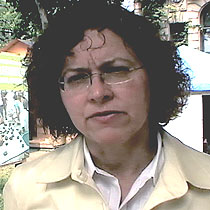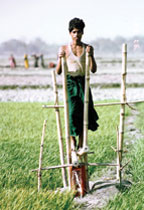2007年VOA标准英语-Tools to Improve Lives, Health in the Developin
搜索关注在线英语听力室公众号:tingroom,领取免费英语资料大礼包。
(单词翻译)
By Carolyn Weaver1New York
09 August 2007
Design is a topic most often associated with luxury goods. But an exhibit at the Cooper-Hewitt National Design Museum in New York focuses on innovative2 ways to address the needs of the world's poor. The objects on display represent a new trend in design, one that mixes sustainable and recycled materials with ancient knowledge and high technology.
 |
| The Cooper-Hewitt's Cynthia Smith curated the exhibit |
The United Nations says 90 percent of the world's population lacks the money to buy even the most basic goods. Life is an endless struggle to get enough water, food, cooking fuel and shelter just to survive.
The outdoor exhibit at the Cooper-Hewitt National Design Museum displays tools to meet those needs, and others that address education, better health, and income-generating work. "The kind of design that's in the show, Design for the Other 90%, really can impact people's lives,” curator Cynthia Smith says. “It can improve lives and even save lives."
For transporting things, there is the Boda bicycle, built long and with a low center of gravity. It can handle large loads of goods, or two passengers in addition to the bicyclist. For carrying water home, there's the Q Drum, a plastic container shaped like a ring or doughnut, with a hole in the middle.
“You put the water inside the doughnut,” Smith says, “and then you roll it along the ground -- as opposed to putting it on your head, or pushing it with a wheelbarrow."
 |
| Micro-irrigation devices on display include this foot-operated bamboo treadle pump for drawing up ground water |
"You use it with a walking motion,” Smith says. “It brings water up from the ground, costs roughly $40. Over two million are in use today. The impact for that one is that in Bangladesh alone, they've increased their net income by $1.4 billion."
The pot-in-pot cooler keeps vegetables fresh for days -- making it possible to earn money from produce that would otherwise spoil before it could be brought to market. "It's designed by Mohammed Bah Abba, an engineer out of Nigeria,” Smith says. “It's one ceramic4 pot inside another ceramic pot. Between the two pots, there's sand. You pour water into the sand, and as the air evaporates, the hot air escapes from the center of the pot, and leaves cool air."
Sergio Palleroni is an architecture professor who designs for poor communities. His group's solar cooker is made from scrap5 metal, and uses the same principle. Standing6 in front of the cooker, which looks like a mirrored satellite dish with a small black pot hanging in the middle, Palleroni explains how it works.
| Architect Sergio Palleroni designs for poor and squatter communities |
The cooker is faster than an ordinary stove, and saves both trees and the hours people formerly9 spent searching for fuel. Hundreds of families can cook at once on giant versions, which follow the sun with clockwork mechanisms10 made of bicycle parts. While the sun’s heat concentrates on a long metal cooking bar, the rest of the device remains11 cool. "It allows people to cook from what's really abundant along the equatorial belt,” Palleroni says. “Most poverty happens along the equatorial belt. And one resource you have in abundance is the sun."
Other highlights of the show include a fleet of motorcycles that carry wireless12 Internet from village to village, and furniture built of wood salvaged13 after Hurricane Katrina.
 收听单词发音
收听单词发音 




